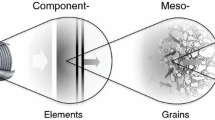Abstract
This and an accompanying paper track a range of thresholds for the response of condensed matter under loading in compression, from the ambient state to the point at which the material bond strength is overcome and it becomes warm dense matter. The threshold considered here is the weak shock limit that differentiates weak- from strong shock dynamic loading. This work examines this threshold and shows a correlation with the theoretical strength of the material. The structure of the shock that evolves has steady and unsteady phases that sweep different regions in a target in differing manners. This is put in context with scale to show it as a transit to a hydrodynamic regime. Limits on the applicability of solid mechanics are discussed in relation to the mechanisms observed.






Similar content being viewed by others
References
Bourne, N.K., On Designing Structures for Extreme Environments. Int. J. Imp. Engng., 2012. 48: p. 107-115.
Bourne, N.K., Materials in Mechanical Extremes: Fundamentals and Applications. 2013, Cambridge: Cambridge University Press.
Liou, J.-C., A statistical analysis of the future debris environment. Acta Astronautica, 2008. 62: p. 264-271.
Liou, J.-C. and N.L. Johnson, Risks in space from orbiting debris. Science, 2006. 311: p. 340-341.
G. Wadsworth: Basic Research Needs for Materials under Extreme Environments, 2007, BES, DoE, US, http://science.energy.gov/~/media/bes/pdf/reports/files/muee_rpt.pdf, Accessed July 2014.
Pokluda, J., M. Cerny, P. Sandera, and M. Sob, Calculations of theoretical strength: State of the art and history. Journal of Computer-Aided Materials Design, 2004. 11: p. 1-28.
Paxton, A.T., P. Gumbsch, and M. Methfessel, A quantum mechanical calculation of the theoretical strength of metals. Phil. Mag. Letters, 1991. 63: p. 267-274.
Ashcroft, N.W., Nature, 2009. 458: p. 158-159.
Rousseau, B. and N.W. Ashcroft, Interstitial Electronic Localization. Phys. Rev. Lett., 2008. 101: 046407.
N.K. Bourne: Proc. R. Soc. A, 2006, vol. 462, pp. 3061–80
N.K. Bourne: Proc. R. Soc. A, 2006, vol. 462, pp. 3213–31.
Fortov, V.E., Extreme States of Matter: On Earth and in the Cosmos. Elsevier, Amsterdam, 2011.
Davison, L. and R.A. Graham, Shock compression of solids. Phys. Rep., 1979. 55: p. 255-379.
Koenig, M., A. Benuzzi-Mounaix, A. Ravasio, T. Vinci, N. Ozaki, S. Lepape, D. Batani, G. Huser, T. Hall, D. Hicks, A. MacKinnon, P. Patel, H.S. Park, T. Boehly, M. Borghesi, S. Kar, and L. Romagnani, Progress in the study of warm dense matter. Plasma Phys. Control. Fusion 2005. 47: B441.
Moriarty, J.A., L.X. Benedict, J.N. Glosli, R.Q. Hood, D.A. Orlikowski, M.V. Patel, P. Söderlind, F.H. Streitz, M. Tang, and L.H. Yang, Robust Quantum-Based Interatomic Potentials for Multiscale Modeling in Transition Metals. J. Mater. Res., 2006. 21: p. 563.
Soderlind, P. and J.A. Moriarty, Phys. Rev. B 1998. 57: p. 10340-10350.
Bourne, N.K., Materials’ Physics in Extremes: Akrology. Metall. Mater. Trans. A., 2011. 42: p. 2975-2984.
Frenkel, J., Z. Phys., 1926. 37: p. 572.
S.P. Marsh: in LASL Shock Hugoniot Data, University of California Press, Berkeley, CA, 1980.
M. van Thiel: Compendium of Shock Wave Data, Lawrence Radiation Laboratory, Livermore, CA, 1966.
Bourne, N.K., The Limits of Strength in Materials in the Condensed Phase. J. Phys.: Conf. Series, 2014. 500: 112010.
Richter, G., K. Hillerich, D.S. Gianola, R. Monig, O. Kraft, and C.A. Volkert, Ultrahigh Strength Single Crystalline Nanowhiskers Grown by Physical Vapor Deposition. Nano Lett., 2009. 9(8): p. 3048-3052.
N.K. Bourne: Metall. Mater. Trans. A, 2014, this volume.
G.T. Gray, III: in ASM Handbook. Mechanical Testing and Evaluation, vol. 8, H. Kuhn and D. Medlin, eds., ASM International, Materials Park, OH, 2000, pp. 530–38.
Author information
Authors and Affiliations
Corresponding author
Additional information
Manuscript submitted May 5, 2014.
Rights and permissions
About this article
Cite this article
Bourne, N.K. On the Ultimate Strength of Condensed Matter. Metall Mater Trans A 46, 4498–4505 (2015). https://doi.org/10.1007/s11661-014-2419-6
Published:
Issue Date:
DOI: https://doi.org/10.1007/s11661-014-2419-6




